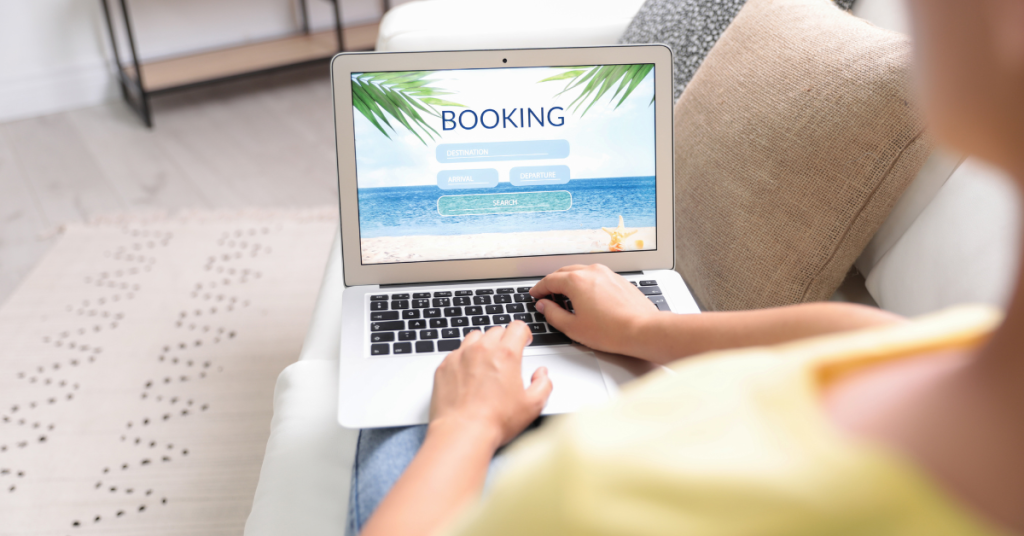Navigational Simplicity: Enhancing User Experience for Seamless Exploration

Navigation lies at the heart of a travel agency website’s user experience. It’s the compass that guides visitors through the vast array of destinations, packages, and information available. Achieving navigational simplicity is crucial for ensuring that users can easily find what they’re looking for and enjoy a seamless exploration journey. Let’s delve deeper into the key aspects of enhancing user experience through navigational simplicity:
A. Clear and Intuitive Menus:
- The navigation menu serves as the primary roadmap for users to navigate the website. It should be prominently placed, easily accessible, and organized in a logical hierarchy.
- Utilize clear and descriptive labels for menu items, avoiding jargon or ambiguous terminology. Categorize content based on user needs and preferences, such as destinations, travel packages, blog, and contact information.
B. User-Friendly Search Functionality:
- While menus provide structured navigation, search functionality offers users a quick and direct way to find specific information or destinations.
- Implement a robust search feature that allows users to enter keywords, filters, or parameters relevant to their travel interests. Ensure that search results are accurate, comprehensive, and presented in a user-friendly format.
C. Consistent Layout and Design Patterns:
- Consistency in layout and design elements enhances usability and familiarity, reducing cognitive load for users. Maintain consistent navigation placement, styling, and interaction patterns across all pages of the website.
- Use visual cues such as color, typography, and iconography to differentiate navigational elements and guide users’ attention to important areas of the website.
D. Minimize Clutter and Distractions:
- Cluttered interfaces can overwhelm users and hinder their ability to navigate effectively. Keep the layout clean, decluttered, and focused on essential content and functionality.
- Avoid unnecessary distractions such as excessive advertisements, pop-ups, or irrelevant content that can disrupt the user’s navigation flow and detract from the overall user experience.
E. Seamless Cross-Device Compatibility:
- With the proliferation of mobile devices, ensuring seamless navigation across various screen sizes and resolutions is paramount.
- Adopt responsive design principles to optimize the website’s layout and navigation for desktops, laptops, tablets, and smartphones. Test navigation performance and usability across different devices and browsers to identify and address any usability issues.
F. User Feedback and Iterative Improvement:
- Solicit feedback from users through surveys, user testing, and analytics to identify pain points and areas for improvement in navigation.
- Continuously iterate and refine the website’s navigation based on user feedback and data insights. Monitor user behavior metrics such as bounce rate, time on page, and navigation path analysis to gauge the effectiveness of navigational changes.
Optimizing for Mobile: Accessing Adventure on the Go
In an era dominated by mobile devices, optimizing travel agency websites for mobile responsiveness is no longer optional—it’s imperative. With an increasing number of travelers relying on smartphones and tablets to research destinations, compare prices, and make bookings on the go, ensuring a seamless mobile experience is essential. Let’s explore the key strategies for optimizing travel agency websites for mobile devices:
A. Responsive Design:
- Responsive web design enables websites to adapt dynamically to different screen sizes, resolutions, and orientations, providing a consistent and user-friendly experience across devices.
- Implement fluid grids, flexible images, and media queries to create a responsive layout that adjusts seamlessly to the viewport dimensions of smartphones, tablets, and desktops.
B. Mobile-Friendly Navigation:
- Mobile users interact with websites differently than desktop users, often relying on touch gestures and smaller screens. Simplify navigation by using mobile-friendly menu designs such as hamburger menus, accordion menus, or tabbed navigation.
- Ensure that clickable elements are adequately spaced and large enough to accommodate touch inputs, minimizing the risk of accidental taps and enhancing usability.
C. Fast Loading Speeds:
- Mobile users are typically on the move and have limited patience for slow-loading websites. Optimize page load times by compressing images, minifying CSS and JavaScript files, and leveraging browser caching.
- Prioritize content delivery and reduce server response times to ensure a smooth and responsive browsing experience, even on slower mobile networks.
D. Streamlined Content Presentation:
- On mobile devices, screen real estate is limited, requiring careful consideration of content prioritization and presentation. Condense lengthy paragraphs, prioritize essential information, and use collapsible sections or tabs to conserve space.
- Optimize images and multimedia content for mobile viewing, ensuring that they load quickly and are displayed effectively on smaller screens without compromising quality.
E. Mobile-Friendly Forms and CTAs:
- Simplify form fields and streamline the checkout process to minimize friction for mobile users. Use autofill and input masks to expedite data entry and reduce user effort.
- Ensure that calls-to-action (CTAs) are prominently displayed and easily tappable, guiding users towards desired actions such as booking a trip, subscribing to newsletters, or contacting the agency.
F. Cross-Device Testing and Optimization:
- Conduct thorough testing across a diverse range of mobile devices, platforms, and browsers to identify and address compatibility issues, layout inconsistencies, and usability challenges.
- Leverage tools such as Google’s Mobile-Friendly Test and browser developer tools to assess mobile compatibility and diagnose potential issues proactively.
Harnessing the Power of Storytelling: Evoking Wanderlust Through Content
In the realm of travel, storytelling is a potent tool for inspiring wanderlust and fostering emotional connections with destinations. Travel agency websites have the unique opportunity to leverage storytelling to captivate audiences, ignite their imagination, and compel them to embark on transformative journeys. Let’s delve into the key strategies for harnessing the power of storytelling to evoke wanderlust through content:
A. Crafting Compelling Narratives:
- Stories have the power to transport readers to distant lands, evoke emotions, and create lasting memories. Craft engaging narratives that evoke the essence of each destination, weaving together history, culture, and personal experiences.
- Incorporate elements of adventure, discovery, and human connection to resonate with travelers’ aspirations and desires for meaningful experiences.
B. Visual Storytelling with Multimedia:
- Visual content such as high-quality images, videos, and immersive multimedia experiences can enhance storytelling by providing a captivating visual backdrop to narratives.
- Showcase stunning landscapes, vibrant cultures, and authentic experiences through visually compelling imagery and multimedia content that evoke a sense of awe and wonder.
C. Personalization and Authenticity:
- Personalize storytelling by highlighting real-life experiences, testimonials, and user-generated content from travelers who have embarked on memorable journeys.
- Emphasize authenticity and transparency in storytelling, avoiding overly promotional or embellished narratives. Authenticity fosters trust and credibility, resonating with travelers seeking genuine and immersive experiences.
D. Interactive and Experiential Content:
- Engage audiences through interactive storytelling experiences that invite participation and exploration. Incorporate interactive maps, virtual tours, and immersive multimedia experiences to immerse users in the destination’s sights, sounds, and sensations.
- Encourage user engagement and interaction through storytelling elements such as quizzes, polls, and interactive storytelling formats that invite users to become active participants in the narrative.
E. Inspirational and Educational Content:
- Beyond merely promoting destinations, use storytelling to inspire, educate, and empower travelers with valuable insights, tips, and resources.
- Offer informative travel guides, destination highlights, and insider tips that enrich the traveler’s journey and empower them to make informed decisions.
F. Integration Across Website Channels:
- Integrate storytelling seamlessly across various channels of the website, including blog posts, destination pages, itinerary descriptions, and social media platforms.
- Create a cohesive storytelling narrative that unfolds organically throughout the user journey, from initial inspiration and discovery to trip planning and booking.
Integrating Booking Systems: Streamlining the Reservation Process

Efficient and user-friendly booking systems are the backbone of a successful travel agency website. By seamlessly integrating booking functionality, travel agencies can streamline the reservation process, enhance user experience, and ultimately drive conversions. Let’s explore the key strategies for integrating booking systems effectively:
A. Robust Reservation Platforms:
- Selecting a reliable booking platform is critical for ensuring seamless reservation management and transaction processing. Choose a booking system that is tailored to the specific needs of the travel industry, offering features such as customizable booking forms, real-time availability updates, and secure payment processing.
- Consider factors such as scalability, flexibility, and integration capabilities when evaluating booking platforms to ensure compatibility with the website’s requirements and future growth.
B. User-Friendly Booking Interfaces:
- Design intuitive and user-friendly booking interfaces that guide users through the reservation process with ease. Minimize friction points by simplifying form fields, providing clear instructions, and offering helpful tooltips or prompts.
- Implement a step-by-step booking workflow that breaks down the reservation process into manageable stages, allowing users to progress smoothly from selecting dates and accommodations to reviewing booking details and completing payment.
C. Seamless Integration with Website Design :
- Seamlessly integrate booking functionality into the website’s design and navigation structure to create a cohesive user experience. Ensure that booking forms and call-to-action buttons are prominently displayed and easily accessible from relevant pages.
- Maintain consistency in design elements, branding, and user interface patterns across the booking system and the rest of the website to reinforce trust and credibility.
D. Real-Time Availability and Pricing Updates:
- Provide users with accurate and up-to-date information on the availability of accommodations, flights, tours, and other travel services. Implement real-time inventory management and pricing updates to prevent overbooking and ensure pricing transparency.
- Display dynamic pricing information based on factors such as seasonality, demand fluctuations, and promotional offers, allowing users to make informed decisions and capitalize on available deals.
E. Secure Payment Processing:
- Prioritize the security of users’ payment information by implementing robust encryption protocols, PCI compliance standards, and secure payment gateways. Offer multiple payment options to accommodate diverse preferences and ensure a seamless checkout experience.
- Clearly communicate the security measures in place and provide reassurance to users regarding the confidentiality and integrity of their personal and financial data.
F. Post-Booking Support and Communication:
- Enhance the post-booking experience by providing users with confirmation emails, booking summaries, and relevant travel information such as itinerary details, booking references, and contact information for customer support.
- Proactively communicate with users throughout the booking process, offering assistance and support as needed and addressing any inquiries or concerns promptly to instill confidence and satisfaction.
Website Design for Travel Agencies Conclusion
In conclusion, designing a compelling website for travel agencies goes beyond aesthetics; it’s about crafting a seamless user experience that inspires wanderlust and facilitates seamless exploration.
By understanding the unique needs of travel agency websites and implementing strategies such as captivating storytelling, intuitive navigation, mobile optimization, and streamlined booking systems, agencies can create digital platforms that resonate with travelers and drive conversions.
As the digital landscape continues to evolve, embracing innovation and prioritizing user-centric design principles will be key to staying ahead in the competitive online travel marketplace.
Ultimately, a well-designed website not only showcases destinations but also cultivates a sense of adventure, turning dreams of travel into unforgettable experiences for explorers around the globe.




